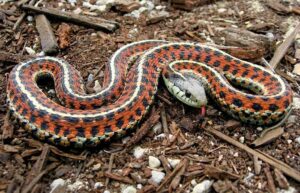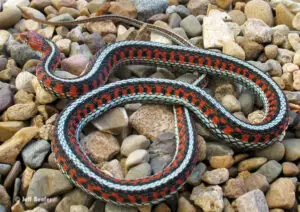Garter snakes, commonly found across North America, are known for their adaptability and diverse diet. While they typically munch on insects, earthworms, and small amphibians, there’s always curiosity about whether these snakes might have a taste for slightly larger prey, like chipmunks. So, do garter snakes eat chipmunks?
Garter snakes primarily feed on a diet of insects, earthworms, small amphibians, and sometimes fish. They are not typically known to eat chipmunks. Chipmunks are larger than the usual prey items of garter snakes, and it would be uncommon for a garter snake to capture and consume a chipmunk.
Also, garter snakes are opportunistic feeders, but their diet generally consists of smaller prey that is easier for them to handle.
Importance of diet in the life of a garter snake

Diet plays a crucial role in the life of a garter snake, as it does for all animals. Garter snakes are carnivorous reptiles that primarily feed on a variety of prey, including amphibians, insects, earthworms, small rodents, and fish. Their diet is essential for their growth, energy, reproduction, and overall health.
Here are some key points highlighting the importance of diet in the life of a garter snake:
- Nutritional Requirements: Garter snakes require a balanced diet to obtain essential nutrients like proteins, fats, vitamins, and minerals. These nutrients support their metabolic processes, growth, and maintenance of bodily functions.
- Energy Source: The food consumed by garter snakes provides them with the energy needed for various activities, including movement, hunting, and reproduction. Without an adequate diet, they may become lethargic and less active.
- Growth and Development: Juvenile garter snakes need a nutrient-rich diet to support their rapid growth and development. Adequate food intake ensures that they reach maturity at the right size and age.
- Reproduction: For adult female garter snakes, a proper diet is crucial for successful reproduction. Nutrients obtained from their diet support egg development and provide energy for the birthing process.
- Health and Immunity: A balanced diet contributes to a garter snake’s overall health and immune function. Proper nutrition helps them resist diseases and parasites, reducing their susceptibility to illnesses.
- Environmental Adaptation: Garter snakes often inhabit various habitats, from forests and grasslands to wetlands and gardens. Their diet may vary depending on their environment, allowing them to adapt to different food sources and survive in diverse ecosystems.
Do garter snakes eat chipmunks?
Garter snakes primarily feed on smaller prey such as amphibians, insects, earthworms, small rodents, and fish. While garter snakes are not typically known to prey on chipmunks due to the size difference and the fact that chipmunks are not part of their usual diet, there have been rare instances where garter snakes have been observed consuming small mammals like young mice or voles.
However, it’s essential to understand that such occurrences are infrequent and not typical of garter snake behavior. Garter snakes are generally opportunistic feeders, meaning they consume what is readily available and suitable for their size and hunting capabilities.
Chipmunks are relatively large compared to the typical prey of garter snakes. Their diet primarily consists of smaller animals that they can easily capture and swallow. Chipmunks are also more agile and can defend themselves against potential predators like garter snakes.



